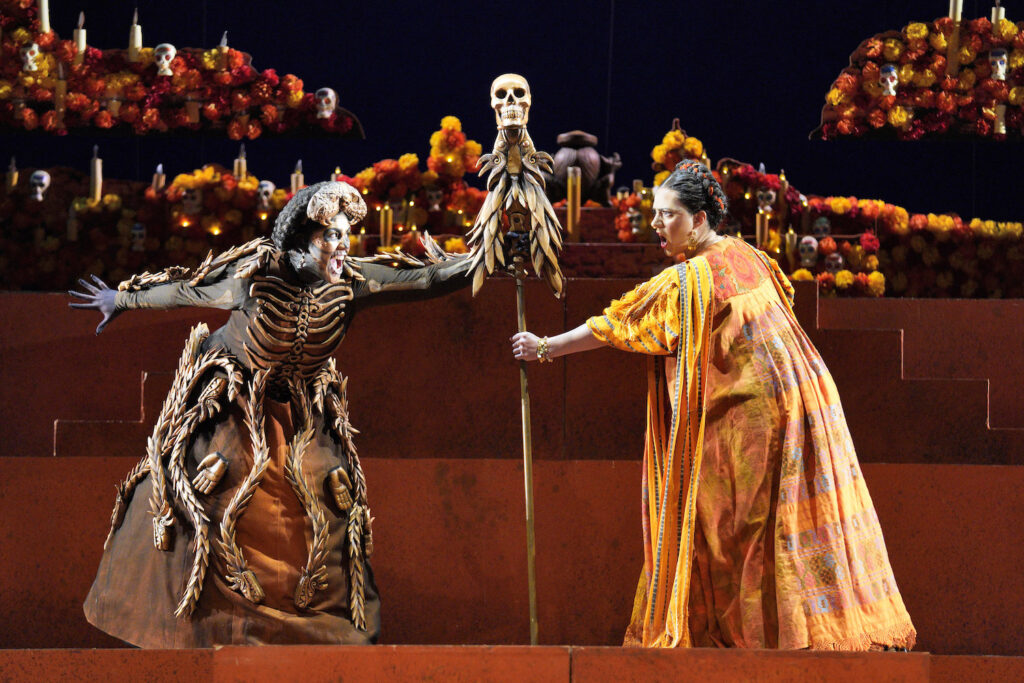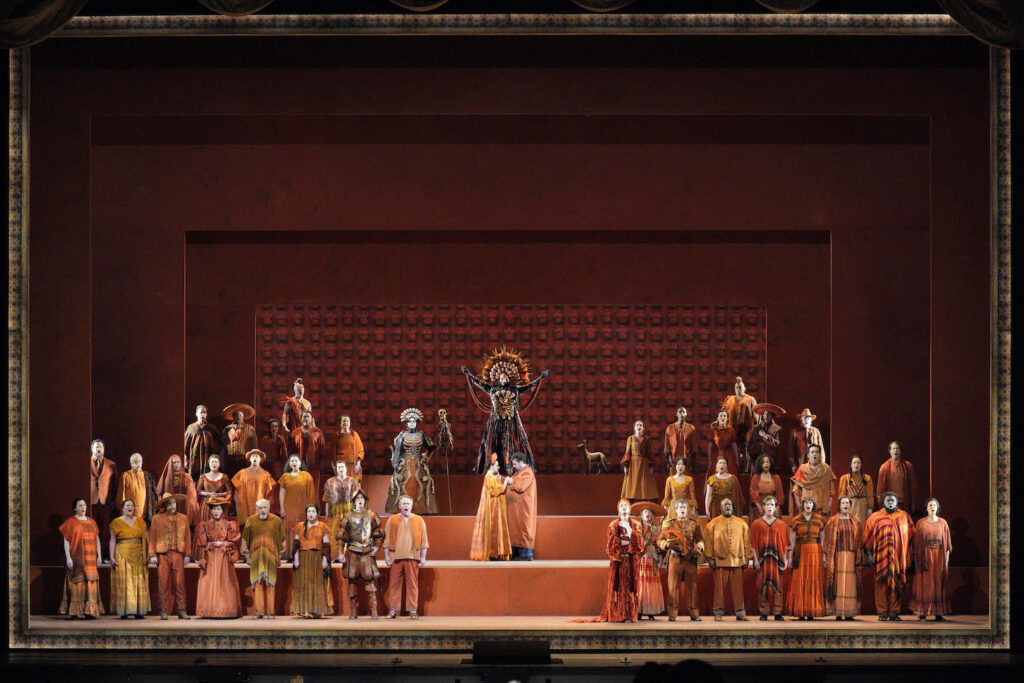History according to opera is a wondrous thing. Just now in San Francisco Frida Kahlo and Diego Rivera have gone off into the sunset (eternity) together, happily reconciled. All this thanks to the most colorful and festive festival of them all, called Dia de los Muertos!
Though the same day as All Souls’ Day (November 2) when Old World Christians remember their dear departed families, New World Mexican Christians allow their dead to come back into the world for this one day, with the help of the Aztec Goddess of Death, Catrina who serves Mictēcacihuātl, Queen of the Aztec underworld.
Here’s the action of the opera: Diego comes into a Day of the Dead altar (huge), where he begs Frida, now a resident of the underworld, to come to him (the couple was famed for the impossibility of being together and the impossibility of being apart). Down there, goddess Catrina implores Frida to return to Diego. After great hesitation, and consultation with a Greta Garbo dressed countertenor, Frida agrees to the rules — 24 hours max, no caresses. Frida and Diego take a walk in Alameda Park where they meet the Greta Garbo travesty. They all go to Casa Azul [Frida’s actual home, now a museum] where Frida eventually embraces Diego after all. She is racked by pain. Diego wants to follow Frida back into the underworld. He does.

The opera is a musical meditation on textural elaborations of each of these settings and situations, created by Cuban American playwright Nilo Cruz. The libretto is divided into 21 relatively brief scenes, much like Wozzeck’s 15 scenes and Death in Venice’s 17 scenes, that manage to describe the bodies of the artists, to explore the creative impasses suffered by both artists, to mention their flamboyant sexual encounters (including a lesbian reference), all this while imparting the fatal attraction of Frida and Diego and evoking the colors, excitement and majesty of the Day of the Dead.
American composer Gabriela Lena Frank, whose mother is of Chinese Peruvian descent and whose father was in the Peace Corps in Peru, created the music, investing the text with a flow of comprehensible intervals that sometimes become chiseled. It was in keeping with contemporary standards of setting texts, eschewing the stepwise progression of normal speech. There was as well a pleasing use of melisma to embellish text, a reference South American music and to the Latina persona Mme. Frank has embraced.
Complying to the budgetary restrictions of American opera companies, Gabriela Lena Frank scored her opera for double winds, not too many brass, timpani, two percussion, harp, piano/celeste and strings. The celeste was used from time to time to create quite beautiful flights of exotic tone outside the normal orchestration, much like Peruvian flutes. As well she created wind instruments flights, exact replicas of Benjamin Britten’s riffs of sexual infatuation in Death in Venice. There were, disappointingly, very few moments of blaring brass, barely hinting at, never imitating Mariachis.
Mme. Frank is a conservative composer, giving extended life to twentieth century European musical style.
The production was however totally Mexican. Sra. Lorena Masa was the stage director, gold framing the Day of the Dead altar, and gold framing smaller portraits of the opera’s players from time to time, finishing the opera with Diego and Frida in the framed pose of the wedding portrait she painted while they lived in San Francisco. Set Design was by Jorge Ballina who conjured a fine Day of the Dead altar that cannily rose to hover over the underworld, then created a Diego studio and Frida Casa Azul worthy of famed Mexico City architect Luis Barragan, all on the platforms on which the final tableau stood — the forty choristers and, finally, the Queen of the Underworld (though she did not sing) — in golden, Aztecan glory.

Costumes were created by Sra. Eloise Kazan in touristically referential Mexican styles. There were as well exotic costumes, like the goddess Catrina and the underworld queen, not to mention the Frida costumes, based on her famous get ups.
The real costume show was however to be seen in the lobby — the costume designer herself wore a grand headdress (gratefully removed during the performance as she sat in front of me), the light green silk brocade jacket and matching tie of Sr. Victor Zapatero, the lighting designer, was spectacular. There were fine, embroidered shirts worn by the many Latinos in the audience, and restrained and outrageous attempts at Frida colors and style on both men and women. It was a very festive, very dressy audience.
Frida was sung by Argentina born, mezzo soprano Daniela Mack who found Frida’s brashness, her confidence and her vulnerability in a strongly sung performance. The role is lengthy and obviously difficult, delivered with pleasing elan by Mlle. Mack. The opera gives vocally spectacular fireworks to the goddess Catrina, sung by Chilean soprano Yaritza Véliz who delivered as required. Leonardo, the Greta Garbo travesty role was sung by American countertenor Jake Ingbar with a warm, masculine soprano tone, and acted the role with feminine aplomb. Mexican baritone Alfredo Daza had the probably impossible task of playing Diego Rivera — a trouble-maker with an enormous personality, and a prolific lover as well. Mr. Daza is a fine singer indeed, who gave it his best shot. Mexican conductor Roberto Kalb urged the San Francisco Opera Orchestra to a polished, full bodied reading of the score, making its more exotic moments shine brightly.
For the first time in its 100 year history the San Francisco Opera Chorus was asked to sing in Spanish! The chorus presence in the tableaus of El Ultimo Sueño de Frida y Diego was huge, and it is difficult music. It was a virtuoso performance by this superb chorus.
Composer Gabriela Lena Frank is currently the resident composer of the Philadelphia Orchestra. She lives in Boonville, CA.
Michael Milenski